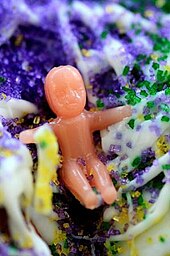king cake
Jump to navigation
Jump to search
See also: kingcake
English[edit]


Etymology[edit]
Probably a calque of French galette des rois (literally “galette of the kings”), meaning the three Magi who visited the baby Jesus at Epiphany.
Pronunciation[edit]
- (Received Pronunciation, General American) IPA(key): /kɪŋ keɪk/
Audio (AU) (file)
Noun[edit]
king cake (countable and uncountable, plural king cakes)
- (Louisiana) A decorative cake distributed among friends or visitors on Epiphany. In many traditions it contains a pea, a trinket or some other small object which entitles its finder to be the "king" for one day.
- 1901, “Twelfth Night or King's Cake. Gateau du Roi.”, in The Picayune's Creole Cook Book, 2nd edition, New Orleans, La.: The Picayune, →OCLC, pages 314–315:
- A pretty superstition was also connected with the King's Cake. The lucky finder of the pecan, or bean, or ring, which was hidden within was henceforth to be favored by fortune. The queen cut the bean in two, and gave half of it to her king, and so, if a gentleman found it. The lucky bean was faithfully preserved as a talisman, and in many an old Creole family to-day there is carefully preserved a little shriveled amulet which was found in the Gateau du Roi on Twelfth Night.
- 2003, Marcia [G.] Gaudet, “The New Orleans King Cake in Southwest Louisiana”, in Marcia Gaudet, James C. McDonald, editors, Mardi Gras, Gumbo, and Zydeco: Readings in Louisiana Culture, Jackson, Miss.: University Press of Mississippi, →ISBN, page 48:
- In New Orleans, Twelfth Night is the beginning of the Mardi Gras season. The New Orleans Twelfth Night Cake or King Cake, as it is usually called today, is a traditional sweet yeast bread served on Twelfth Night and during the Mardi Gras season. The New Orleans King Cake is shaped to form a crown, and it is decorated with the traditional Mardi Gras colors using gold, purple, and green sugar. A bean or a small china doll was traditionally baked in the cake, but today a small plastic baby is usually hidden in the cake instead.
- 2006, Louise McKinney, New Orleans: A Cultural History, Oxford University Press, →ISBN, page 222:
- Local custom dictates that Carnival has its official beginning when a debutante at her “coming out” ball finds a golden bean in her slice of king cake at the Twelfth Night Revelers’ Ball.
- 2007, Susan Tucker, “King Cakes”, in John T. Edge, editor, Foodways (The New Encyclopedia of Southern Culture; 7), Chapel Hill, N.C.: University of North Carolina Press, →ISBN, page 190:
- King cakes, rich briochelike delicacies, make their appearance on 6 January, or Twelfth Night, and herald the beginning of the Carnival season in New Orleans.
- 2011, Yvonne Spear Perret, “Season According to Taste”, in Yat Wit: Chicken Gumbo for the New Orleans Soul, Gretna, New Orleans, La.: Pelican Publishing Company, →ISBN, page 69:
- Finally, as Mardi Gras draws to a close, the parade-weary, traffic-stressed, kingcake-bloated population of New Orleans is relieved to welcome the onset of the next season—Lent.
- 2014, Julie Murray, “King Cake”, in Mardi Gras (A Buddy Book), Minneapolis, Minn.: ABDO Publishing Company, →ISBN, page 18:
- People eat king cake for Mardi Gras. A king cake is filled with cinnamon, fruit, or cream cheese. A small toy baby is placed inside the cake. It symbolizes the baby Jesus, from Christianity. One person gets the piece of cake with the baby. He or she buys the next king cake or throws the next party.
- 2024 February 12, Rick Rojas, “Outside New Orleans, a New Mardi Gras Experience: The King Cake Drive-Thru”, in The New York Times[1], →ISSN:
- And this year, just outside New Orleans, a tire shop that for as long as anyone can remember sold only car parts has become a bustling marketplace offering king cakes, the delicacy of the Carnival season, in just about any conceivable flavor.
Alternative forms[edit]
Synonyms[edit]
Translations[edit]
cake eaten on Epiphany
|